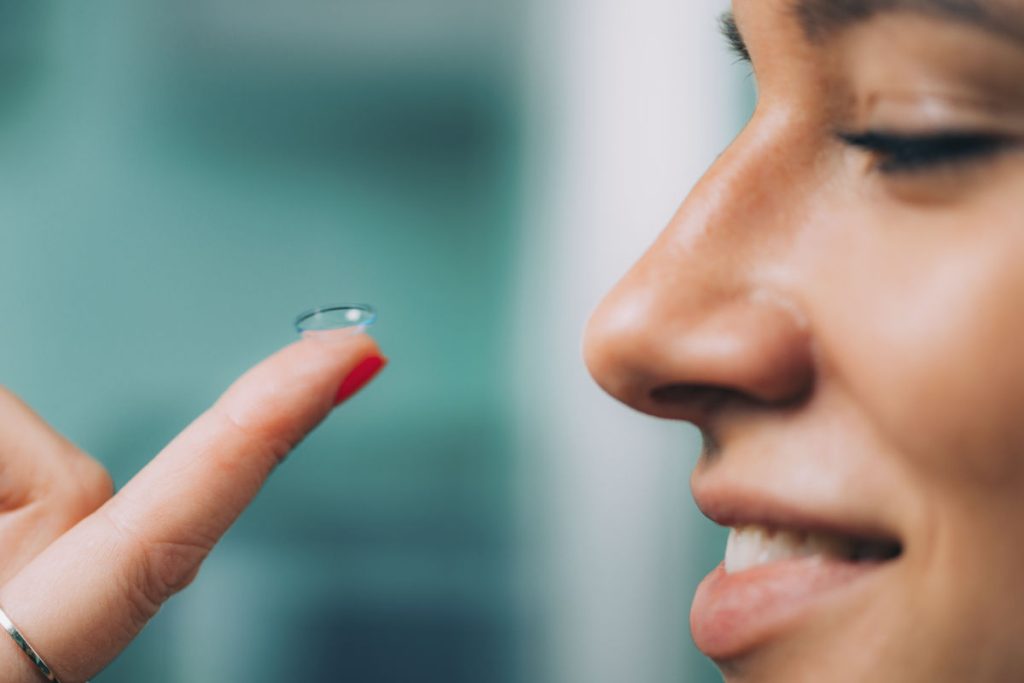
What is orthokeratology?
Orthokeratology (or Ortho-K) is the wearing of special rigid contact lenses which gently reshape the cornea. The cornea is the ‘front window’ of the eye. Alongside the natural lens, the cornea focuses light onto the retina.
Ortho-K works by altering the shape of the cornea, so that light entering the eye can be focused more precisely onto the retina without the need for glasses. It is suitable for those with myopia (shortsightedness).

Orthokeratology works on the principle of using contact lenses to mould the cornea so that it becomes steeper. The Ortho-K contact lenses are worn overnight, and removed in the morning.
The cornea is gradually moulded and reshaped when you wear a set of special rigid gas permeable contact lenses overnight while you sleep. When removed in the morning, the cornea remains in the new shape so you can see clearly without lenses or glasses during the daytime.
Note: This effect is only temporary. The cornea gradually reverts towards its original shape and curvature towards the end of the day. Hence, your vision will return to its original level. To obtain good vision again the next day, you will need to reshape your cornea again by wearing the Ortho-K contact lenses overnight the night before.
Can you benefit from orthokeratology?

Orthokeratology is beneficial for those with myopia (shortsightedness). There is no age restriction for adults as long as you do not have any eye disease. If you have hyperopia (longsightedness), you will not benefit from treatment with Ortho-K.
However, not everyone with myopia is suitable for Ortho-K. For best results, your myopia should be no more than -5.00 diopters. If you have astigmatism, you may still benefit if your astigmatism is no more than 1.50 diopters.
Ortho-K is particularly suited for sports people and appearance-conscious adolescents in whom laser refractive surgery is inappropriate. It is also ideal for those who work in dusty or dirty environments and are therefore unable to wear glasses or contact lenses during working hours. Finally, Ortho-K will also be suitable for those who want to cut down on glasses or contact lenses during the day but do not mind wearing them at night while sleeping.
What are the advantages of orthokeratology?
1. Ortho-K is reversible. The corneal shaping effect is temporary and will eventually wear off once you stop wearing your Ortho-K contact lenses for a few months. After this period, you will be eligible for laser refractive surgery or phakic intraocular lens implantation.
2. Good visual results. In clinical studies of Ortho-K, over 95% were able to achieve the legal driving vision (6/12 or 20/40 vision) without glasses or contact lenses. 20/20 vision can be achieved in up to 70% of Ortho-K contact lens wearers.
3. Ortho-K is cheaper compared to laser refractive surgery and phakic intraocular lens implantation.
What are the disadvantages of orthokeratology?
1. Ortho-K is more expensive when compared to spectacles and the normal contact lenses.
2. The initial process can be a bit fiddly because there is an element of trial and error before desired result can be achieved. You will need to have your corneal shape measured initially. After that, you will need to have the Ortho-K lenses fitted. You may need a series of temporary contact lenses until you finally achieve the level of vision that you are happy with.
3. It may take a few weeks before any improvement in your vision is apparent.
4. You may experience some glare and haloes initially. If you have naturally large pupils, you are more prone to this problem. This settles for most people, but may never completely resolve unless you stop wearing Ortho-K lenses.
5. Ortho-K contact lens wear may cause an increased risk of contact lens related eye problems, such as infection and irritation. This is more common if you do not adhere to precautions regarding their proper use. Make sure you look after your eyes and Ortho-K contact lenses according to the instructions given.

What are the available orthokeratology lenses?
The only 2 Ortho-K lenses that have been approved by the US Food and Drug Administration so far are:
– Paragon Corneal Refractive Therapy
– Bausch & Lomb Vision Shaping Treatment
However, there others that are also available in the market. These include:
– CKR (Eye Care Associates)
– Contex OK-E System (Contex)
– DreamLens (Dreimlens)
– Emerald (Euclid Systems Corporation)
– NightMove (Advanced Corneal Engineering)
– Menicon Z Night
Whichever Ortho-K lens you choose, make sure that it is fitted by a qualified and certified ophthalmologist or eye care practitioner. Remember that the onus is on you to also look after your eyes. You should always follow the recommended instructions regarding how to take care of your eye while wearing the Ortho-K contact lenses.


